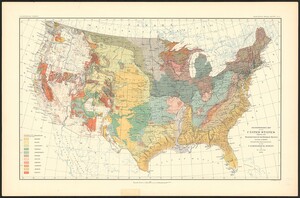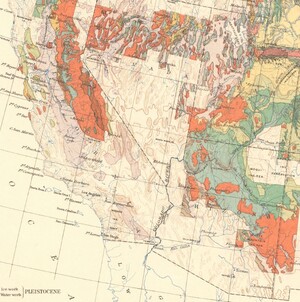Our May Map of the Month is this Reconnoissance Map of the United States by William John McGee from 1893. It displays the geologic variation throughout the regions of the United States as documented at the time by the U.S. Geological Survey and various state Geological Surveys.

This map was originally published in 1885 in response to an 1882 Congressional order that the U.S. Geological Survey should compile a geological map of the country. Having been established only 3 years prior in 1879, the U.S.G.S. had collected or was in the process of collecting a good deal of geologic data on the East Coast, Midwest, and South, but its knowledge of the West and Southwest was significantly less thorough.

As a result, the original 1885 map had very little indication of the geologic variation in those regions, which led W.J. McGee to reproduce this 1893 version of the map on behalf of the U.S.G.S. once they had gathered more data on the West and Southwest regions. However, even in this later compilation of geological data, it is still clear how unexplored and unsurveyed much of the western United States was before the 20th century.

The map shows the distribution of rocks from 13 different geologic eras and rock types throughout the geologic features of the United States. This provides insight into the complex composition of some of North America’s most impressive geological features, such as the Appalachian Mountains. As shown on this map, the Appalachian Mountains are made up of rock from many different eras, including Algonkian, Cambrian, Silurian, and Carboniferous rock.

This Reconnoissance Map of the United States displays a level of detail consistent with the most advanced geologic knowledge and understanding possible in the late 19th century. Since the production of this map, the U.S.G.S. 's knowledge of the geological makeup of the United States, particularly in the west half of the country, has greatly increased. The specificity of geologic categorization has also vastly improved due to the development of modern technologies like radiometric dating. The map also features the historic French spelling of “Reconnoissance” as opposed to the modern English spelling of “Reconnaissance”.

We hope you enjoyed month's map! As with all of our Map of the Month features, if you’d like to learn more about this map, get a scan of this map or schedule a visit to explore our maps in person, please submit a Map and Geo Service Request. We’ll be sure to get back to you within two business days, but typically sooner.
- Kelsey Kerley, Map and GIS Assistant